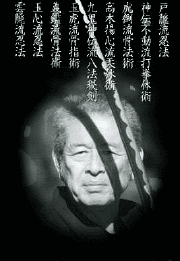The Bujinkan Dojo (武神館道場) was founded by Dr. Masaaki Hatsumi (初見良昭) and named in honour of his teacher, Toshitsugu Takamatsu (高松 寿嗣). The name Bujinkan (武神館) can roughly be translated as Palace of the Divine Warrior.

The Bujinkan principally teaches the nine schools of traditional Japanese martial arts that Hatsumi Sensei inherited from his teacher, Takamatsu Sensei – collectively known as Bujinkan Budo Taijutsu(武神館武道体術).
Many of these old traditional styles, or koryu(古流) were often lost or forgotten after the practice of martial arts in Japan was banned during the post World War II occupation. However, a few dedicated masters manged to keep some of these schools alive during this difficult period. We are indeed very fortunate in that nine such schools have been passed down to us today in the Bujinkan.
Each of these nine schools has it’s own particular characteristic way of movement and contain techniques for use both with and without weapons, some of which are unique to some of the schools.
Several of the schools in the Bujinkan are related to one another and some share similar histories. Some of the schools histories date back almost 900 years.
The schools of the Bujinkan:
- Togakure-ryū Ninpō Taijutsu (戸隠流忍法体術)
- Gyokko ryū Kosshi jutsu (玉虎流骨指術)
- Kuki Shinden Happō Bikenjutsu (九鬼神伝流八法秘剣術)
- Koto Ryū Koppō jutsu (虎倒流骨法術)
- Shinden Fudo Ryū Dakentai jutsu (神伝不動流打拳体術)
- Takagi Yoshin Ryū Jūtai jutsu (高木揚心流柔体術)
- Gikan Ryū Koppō jutsu (義鑑流骨法術)
- Gyokushin-ryū Ryū Ninpō (玉心流忍法)
- Kumogakure Ryū Ninpō (雲隠流忍法)
Hatsumi Sensei: “Taijutsu is an art form, it is your body is expressing itself through movement”.
Guidelines for practice are outlined on the official Honbu Dojo website issued by Dr. Masaaki Hatsumi, Bujinkan Dojo Soke.
Yearly Theme
Every year Hatsumi-sensei chooses a theme to be studied over the next 12 months. This theme is usually a particular school or weapon which is given special attention during the year in addition to normal training.
With nine different schools of martial arts to study, having a theme like this helps ensure a common thread in the training around the world.
The yearly theme is a good opportunity to look at one aspect of the Bujinkan in detail and is often the topic of weekend seminars held throughout the year.
Current Theme
There is currently no theme for 2022.
- 2019: Muto Dori (Unarmed defence against sword).
Soke Hatsumi is continuing with this area of study, all be it at a much higher level of technique & control. For our study at the club, we will also be focusing on the Koto Ryu. - 2018: Koto Ryu & Muto Dori (Unarmed defence against sword).
- 2017: Kannin Doshi (Perseverance of mutual respect. Respect yourself and respect your opponent.).
- 2016: Katana
- 2015: Nagamaki
- 2014: Shin In Bu Do
- 2013: Ken, Muto Dori.
- 2012: Kaname (vital/pivot point, such as the pin which holds a Japanese folding fan together) and the weapon for the year is Katana.
- Kaname is often interpreted as meaning the vital/pivot point of the technique being applied, but perhaps this is a misinterpretation. It may actually refer to the vital point within ourselves when we are applying the technique.
- 2011 Kihon Happou 季翻初崩 Kihon Happou 季翻初崩
- 2010 Rokkon Shoujou (禄魂笑浄) Tachi (main weapon for 2010).
- 2009 No Theme / Focus on “Sainou Tamashii Utsuwa” – Ability/Talent, Soul/Spirit, Capacity/Container. Study Rope Sword
- 2008 Togakure Ryu Ninpo Taijutsu
- 2007 Kukishin Ryu
- 2006 Shinden Fudu Ryu Dakentaijutsu
- 2005 Gyokko Ryu Kosshijutsu (Bo and Tachi)
- 2004 Daishou JuitaiJutsu (Roppou-Kuji no Biken)
- 2003 Juppo Sessho
- 2002 Takagi Yoshin-ryu
- 2001 Gyokko-ryu
- 2000 Koppo-jutsu
- 1999 Kukishinden-ryu
- 1998 Shinden Fudo-ryu
- 1997 Jo-jutsu
- 1995 Naginata / Daisho
- 1994 Yari / Kodachi
- 1993 Bo-jutsu
- 1996 Ken-jutsu
- Previous themes included Kusari-Fundo, Hanbo and Jutte